Different types of turbines are developed to extract mechanical energy from hydraulic energy to generate electricity. There are several ways to explain the types of turbines. Classification methods include the momentum exchange method between the fluid and the turbine, fluid flow path through the turbine, hydraulic range of the turbine activity, and specific speed of the turbine.
Are you interested in learning about the Functions of Turbines? Here at Linquip, you may find the essentials of a Turbine, its operating principle, classifications, and its uses. Are you looking to purchase Turbine Equipment? You are invited to browse our Turbine For Sale at Linquip, where you have access to See a List of All Turbine Products in Linquip based on your application and requirements.
Additionally, Linquip offers a wide variety of Turbine Suppliers and Companies so that you may choose the right firm and provider for your needs. Linquip has a wide variety of Turbine Manufacturers who can aid you in locating the right equipment for your application. A Turbine Service Provider can also help you manage your industrial equipment service activities, including installs, maintenance, and repairs.
⇒ View a Comprehensive List of Turbines and Their Suppliers ⇐
In the following, we try to explain each of these classification methods.
Types of Turbines Based on Energy Exchange between the water and the Machine
Considering how the fluid flow acts on the turbine blades causes hydro turbines to be classified into two categories: impulse and reaction.
Impulse Turbines
If the turbine wheel is driven by the kinetic energy of the fluid that strikes the turbine blades through the nozzle or otherwise, the turbine is known as an impulse turbine. In these types of turbines, a set of rotating machinery operates at atmospheric pressure. Impulse turbines are usually suitable for high head and low flow rates.
Pelton, Turgo, and Cross-flow turbines are three types of impulse turbines. The construction of the Pelton and Turgo turbines is similar. However, the Cross-flow turbine is a modified type of impulse turbines that is classified as an impulse turbine due to the rotation of the runner at atmospheric pressure and not as a submerged turbine.
Click Here to See All Impulse Turbines
Reaction Turbines
If the sum of potential energy and kinetic energy of water which are due to the pressure and velocity, respectively cause the turbine blades to rotate, the turbine is classified as a reaction turbine. In these types of turbines, the entire turbine is immersed in water and changes in water pressure along with the kinetic energy of the water cause power exchange. Applications of reaction turbines are usually at lower heads and higher flow rates than impulse turbines.
Click Here to See All Reaction Turbines
Reaction turbines are very diverse. Francis, Kaplan, and Deriaz are among these turbines.
This video provides an overview of these two types of turbines and compares them.
Types of Turbines Based on Fluid Direction Through the Machine
The water passage through the turbine divides these turbines into the following four categories:
Radial Flow Turbine
Various examples of water turbine wheels (Reference:publicresearchinstitute.org)
If the flow in the runner moves radially, the turbine is radial flow. These turbines are divided into two types: Inward radial flow and outward radial flow. Francis turbines can be in the form of radial flow turbines.
Inward Radial Flow Turbines
In these turbines, water enters the turbine casing through the Penstock, and travels through the fixed guide vanes to the rotor, and exits from there. Therefore, the inner and outer diameters are as the outlet and the inlet, respectively. The Following figure shows the direction of the water in an inward radial flow turbine.
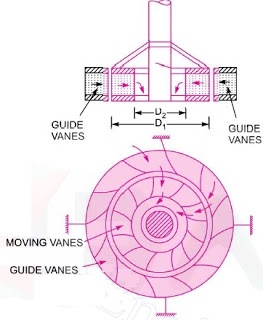
Water enters from the casing in the center of the fixed guide vanes. They direct water into the rotor around the fixed guide wheel. Water is discharged from the outer diameter of the runner. Therefore, the inner diameter of the runner is the inlet, and the outer diameter is the outlet.
The figure below depicts how fluid flows through this type of turbine.
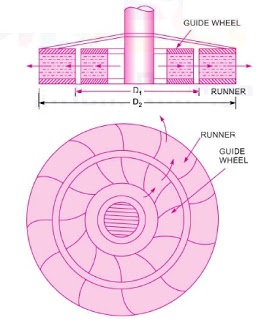
For Find More Information about Turbine Categories:
- See All Gas Turbine Experts
- See All Gas Turbine Service Provider
- See All Gas Turbine Manufactures
- See All Gas Turbine Distributor
Tangential or Peripheral Flow Turbines
In these turbines, water flows in a tangential direction to the runner. Pelton belongs to this category of turbines.
Axial Flow Turbines
In this type of turbine, the fluid flows parallel to the turbine shaft (turbine axis). Kaplan is one of these turbines.
Mixed Flow Turbines
A turbine in which the flow enters the turbine radially and leaves it axially is a mixed flow turbine, like modern Francis turbines.
Types of turbines based on the hydraulic operating range
Accordingly, water turbines are of three categories:
Low Head Turbines
Hydraulic turbines operating in the head range of fewer than 45 meters are considered low-head turbines. Kaplan turbine is one of these turbines. If the head is less than 3 meters, it is considered an ultra-low head.
Medium Head Turbines
The working range for heads of 45 to 250 meters is known as medium heads. Francis turbines generally operate in such conditions.
High Head Turbines
Turbines with heads higher than 250 meters are known as high-head turbines, Like the Pelton Turbine.
In the figure below, you can see the operating range of different turbines based on the changes in head and flow rate.
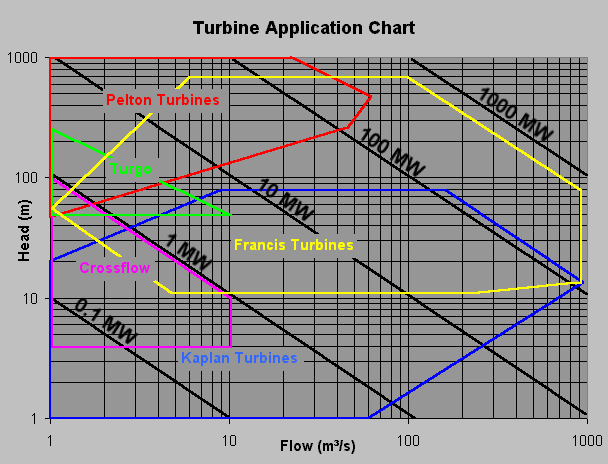
Types of Turbines Based on Specific Speed
The specific speed of a turbine (denoted by Ns) is defined as the speed of a turbine with a geometric similarity that can generate a unit of power under a head unit. Based on this parameter, water turbines are classified into three classes:
Low Specific Speed Turbine
The values between 1 and 10 are low specific speeds. Impulse turbines operate in this range. For example, the Pelton turbine usually operates at a specific speed of about 4.
Medium Specific Speed Turbine
Turbines that operate in the specific speed range of 10 to 100, such as Francis, have a medium specific speed.
High Specific Speed Turbine
Specific speeds above 100 are considered high values. Kaplan turbine works at a high specific speed.
Introduction of Widely Used Industrial Water Turbines and Their Classifications
After explaining different methods of classifying turbines and mentioning some examples for each of them, we will give a brief description of the turbines that are very well known in the electricity generation industry mentioned in the previous sections.
For Find More Information about Turbine Categories:
- What is Gas Turbine?
- What is Aeroderivative Gas Turbine?
- What is Heavy Duty Gas Turbine?
- Gas Turbine For Sales
Pelton
A Pelton turbine is a type of impulse turbine in which the flow enters the wheel tangentially. The whole set is at atmospheric pressure, the flow with potential energy and high pressure flows in the Penstock and reaches the nozzle(s). The nozzle is responsible for converting high-pressure flow to high-speed flow. Therefore, the current hits the blades of this turbine, which are in the shape of a bucket, at high speed and causes the runner to rotate.
Click here to see all pelton turbines
These turbines are suitable for high heads (up to 2000 meters) and low flow rates (4-15 m3/s). They are classified as low specific speed turbines. They are produced in various sizes and have been used up even to a capacity of 200 MW.
In the figure below, you can see the main components of the Pelton turbine, including nozzle(s), deflector plate (to prevent water jets in case of load stop), runner, and bucket-shaped blades.
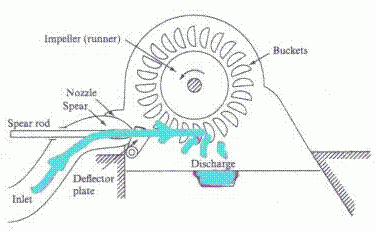
Cross-flow
A cross-flow turbine is a type of modified impulse turbine. Although similar to Pelton or Turgo, it does not have buckets and the flow does not hit the buckets tangentially, because the turbine does not submerge in water, it falls into this category of turbines.
The main components of these turbines are the runner, the blades installed on the runner, the guide vane(s), and the draft tube. The water flows transversely into the runner, exchanging momentum once with the upper blades and once with the lower ones.
Click here to see all Cross flow turbines
These turbines are commonly used in small hydropower plants. They can work in a wide range of the heads (between 2 to 200 meters) and the flows (between 20 to 2000 liters per second). These turbines can be very well adapted in cases where the flow changes to maintain efficiency. The number of blades is between 10 and 34.
The image below illustrates different parts of a Cross-flow turbine.
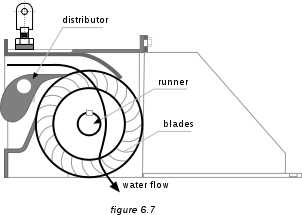
Francis
Francis Turbine is a reaction turbine used for medium heads (10-650 meters) and medium flows. Output power can be from 10 MW to 750 MW. These turbines are in the range of medium specific speed turbines. The main components of these turbines include spiral case, stay vanes, Guide vanes, runner, and draft tube.
The spiral case distributes the water around the wheel, and because its cross-sectional area gradually decreases, it does not allow the water velocity to decrease. The flow is directed to the wheel by stay vanes. Guide vanes are responsible for changes in the direction and velocity of water during changes in flow rate.
Click here to see all Francis Turbine
Finally, the energy exchange takes place in the runner section. The draft tube also acts as an outlet which increases the net head by moving the exiting water level upwards.
The wheels of these turbines are inward radial or mixed. The higher the specific speed, the closer the wheel gets to the mixed flow. The axis of these turbines is made vertically or horizontally; the horizontal type is used for less power and smaller power plants.
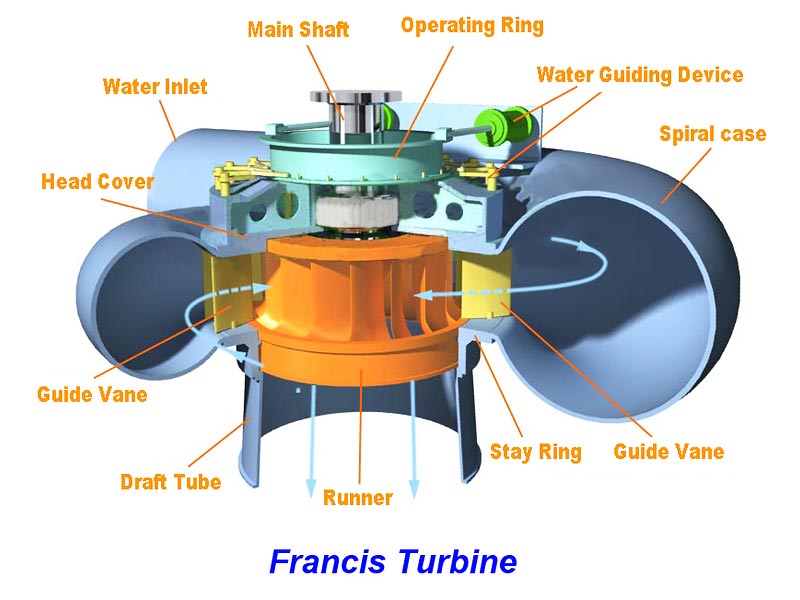
Kaplan
Kaplan is a propeller-type of reaction turbine. Kaplan turbines are used for low heads and high flow rates. The main components of these turbines include spiral case, stay vanes, wicket gates, runner, and draft tube. The water flows radially into the guiding regulator. The spire, blade, and movable vanes act similarly to the Francis turbine. Unlike propellers, blades are adjustable in Kaplan. Therefore, by adjusting the guide vanes and blades, the flow rate can be changed in order to maintain efficiency.
Click here to see all Kaplan Turbine
The Kaplan turbine, whose wheel is axial, is mounted vertically for high power and horizontally for low power and low heads.
The specific speed of these turbines is 2 to 3 times that of Francis and they are classified in the category of high specific speed turbines.
The efficiency chart of these turbines is flat and can maintain its efficiency in a wider range of flow, unlike Francis.
The number of blades is 3 to 6, which is much less than Francis being 11 to 17.
The figure below displays the main components of a Kaplan turbine.
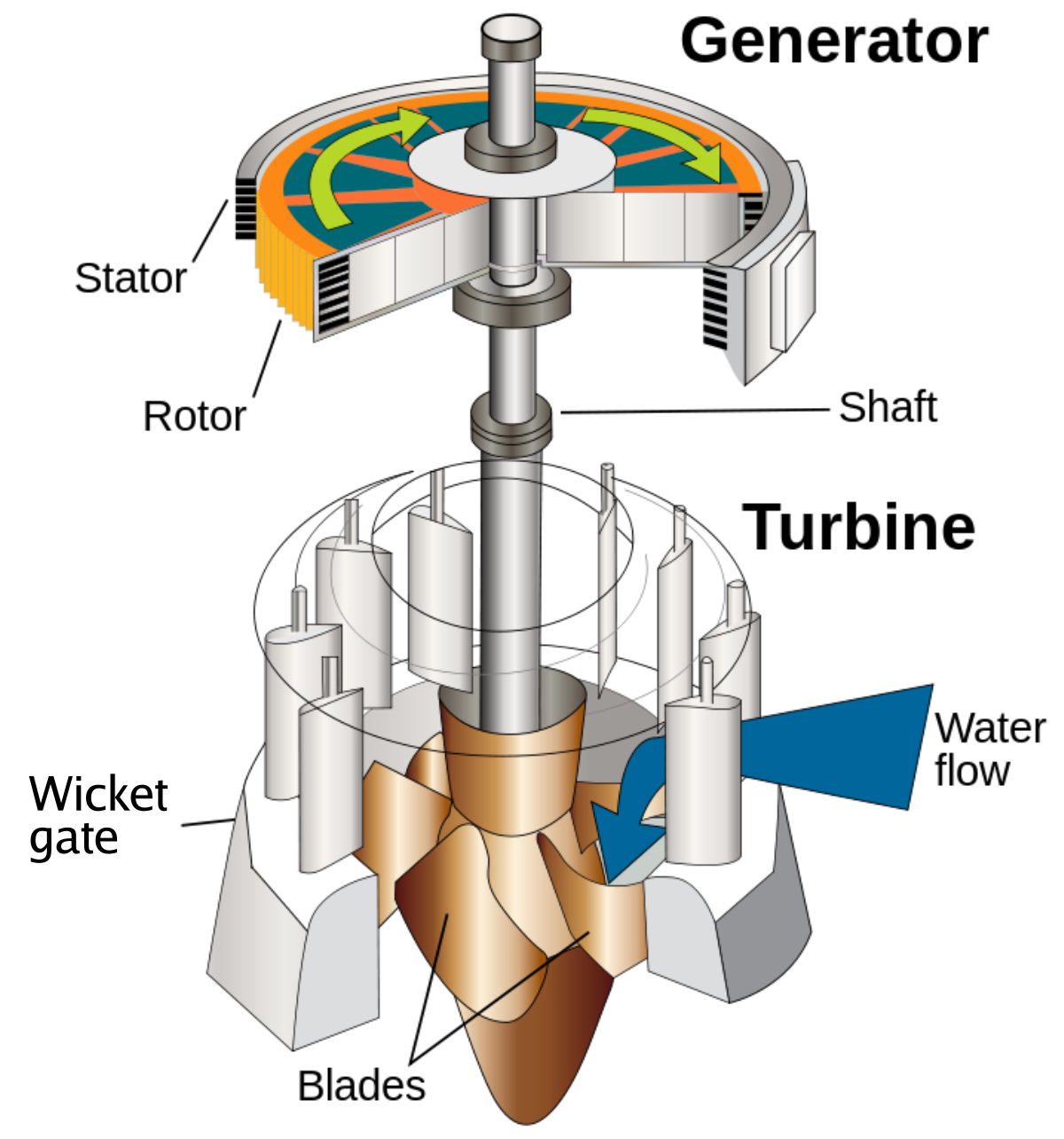
In this video, you can see a schematic comparison of Kaplan, Francis, and Pelton turbines.
In What Ways are Turbines, Pumps, and Compressors Different?
It should now be evident that turbines are used to generate energy from fluid movement, whereas pumps are used to generate fluid movement by utilizing that energy.
The compressor is used to generate energy by increasing pressure, whereas the turbine is used to remove energy by lowering pressure. The turbine turns hydraulic energy into mechanical energy, whereas the compressor converts mechanical energy into heat energy.
Buy equipment or ask for a service
By using Linquip RFQ Service, you can expect to receive quotations from various suppliers across multiple industries and regions.
Click Here to Request a Quotation From Suppliers and Service Providers
Read More on Linquip
- Pelton Whee l| Parts, Types, Working Principle and Efficiency
- Radial Flow Turbine
- Cross-Flow Turbine: Working Principle, Components, and Advantages
- An Ultimate Guide to Francis Turbine
- Mixed Flow Turbine
- What is a Kaplan Turbine? Parts, Types, and Working Principles
- The 8 Best Home Wind Turbines in 2021
- Difference between Impulse and Reaction Turbine
- What is Tesla Turbine and How Does it Works?
- Combined Cycle Gas Turbine
- Open Cycle Gas Turbine
- Closed Cycle Gas Turbine
- Types of Solar Energy: Learn the Basics, Get the Most Out of It!
- Types of Steam Turbine: An easy-to-understand and practical Classification
- Types of boilers: Which one is the best?
- Types of Wind Turbines: The Quick and Easy Intro
- Gas Turbine Type: Overview of Types and Profitable Applications
- Axial Flow Turbines and Working Principles
- Differences between Pelton, Francis, and Kaplan Turbine
- Types of Propellers: Historical Development, and The Ways of Their Construction
- Impulse Turbine: Working Principle, Components, and Types
- Hydrogen Gas Turbine: All You Need to Know
- Hot Gas Path Components Gas Turbine for Sale
- 6B.03Gas Turbine for Sale
- GE 7FA.03 Unit Rotor 7FA.03 for Sale
- 6B Shroud Set Frame Gas Turbine for Sale
- 6B Vane Frame Gas Turbine for Sale
- Top Gas Turbine Manufacturers In US (2022 Update)

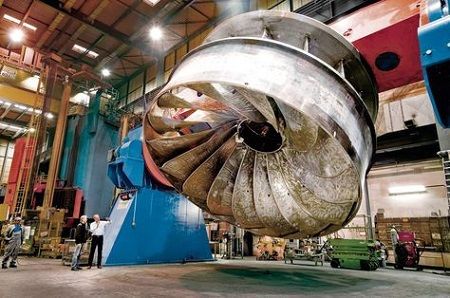
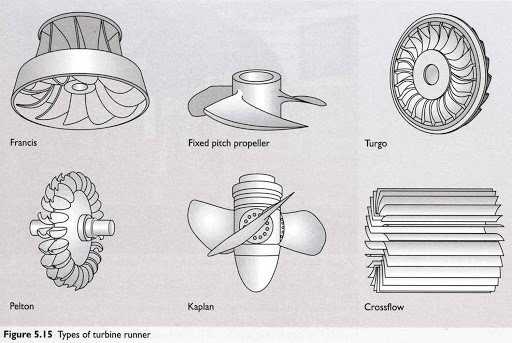


Nice….
Please I want to know more about turbines and I need place be working and studying or doing anything about it,for now I work on gas turbine,as meachinical teachinicial . please I want to be more proffertional help me.
Thanks for visiting our website and leaving your comment, Tom! You are encouraged to visit Linquip Tech News, where you can find similar posts.